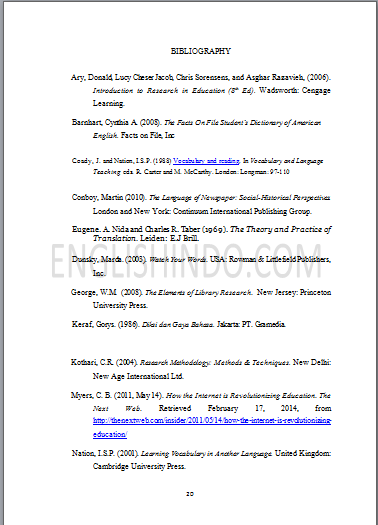Cara Menulis Daftar Pustaka Sumber Dari Internet

Sumber digital sebagai bahan pustaka sudah jamak digunakan. Some says kita harus berhati-hati menggunakan bahan pustaka elektronik, with a pinch of salt kata orang. Harus kita perhatikan kesahihan artikel tersebut. Terlepas dari hal itu, kadang kita bingung bagaimana menuliskannya didalam daftar pustaka. Nah berikut ini caranya. Saya sadur 100% dari situs dan. Berikut tulisan tersebut. Download lagu noah separuh aku mp4.
Daftar Pustaka Sumber Diambil dari Internet. Seperti anda ketahui bahwa keberadaan internet saat ini sudah menjadi hal yang umum di jumpai di kehidupan sekitar. Hal inilah yang membuat cara menulis daftar pustaka bisa anda cari di internet. Hingga saat ini, penulisan daftar pustaka yang bersumber dari internet masih diperdebatkan. Saya sering melihat Cara Menulis Daftar Pustaka Dari Internet yang salah dalam tugas makalah mahasiswa saya. Pertama, kebanyakan format penulisan daftar pustaka dari internetnya amburadul, formatnya tidak standar. Kedua, banyak mahasiswa yang mengambil referensi dari sumber yang kurang meyakinkan.
Semoga bermanfaat ~oOo~ Reference List: Electronic Sources Article From an Online Periodical Note: In 2007, the APA released several additions/modifications for documentation of electronic sources in the APA Style Guide to Electronic References. These changes are reflected in the entries below. Please note that there are no spaces used with brackets in APA.

Online articles follow the same guidelines for printed articles. Include all information the online host makes available, including an issue number in parentheses. Provide a retrieval date only if the information is likely to be updated or changed at a later date (as in the case of blogs and wikis).
Since many online periodicals appear in their “final” form, a retrieval date is not necessary. A., & Author, B. (Date of publication). Title of article.
Title of Online Periodical, volume number(issue number if available). Retrieved month day, year, (if necessary) from Bernstein, M. 10 tips on writing the living Web. A List Apart: For People Who Make Websites, 149. Retrieved May 2, 2006, from Online Scholarly Journal Article Since online materials can potentially change URL’s, APA recommends providing a Digital Object Identifier (DOI), when it is available, as opposed to the URL.
DOI’s are an attempt to provide stable, long-lasting links for online articles. Tux paint zadaniya. They are unique to their documents and consist of a long alphanumeric code. Many-but not all-publishers will provide an article’s DOI on the first page of the document.
Note that some online bibliographies provide an article’s DOI but may “hide” the code under a button which may read “Article” or may be an abbreviation of a vendors name like “CrossRef” or “PubMed.” This button will usually lead the user to the full article which will include the DOI. Find DOI’s from print publications or ones that go to dead links with CrossRef.org’s “DOI Resolver,” which is displayed in a central location on their home page. Article From an Online Periodical with DOI Assigned. A., & Author, B. (Date of publication). Title of article. Title of Journal, volume number.
Doi:0000000000 Brownlie, D. Toward effective poster presentations: An annotated bibliography. European Journal of Marketing, 41(11/12), 1245-1283. Doi:10.11 Article From an Online Periodical with no DOI Assigned Online scholarly journal articles without a DOI require a URL but do not require a retrieval date. Provide a retrieval date only if the information is likely to be updated or changed at a later date (as in the case of blogs and wikis).
Since most journal articles appear in their “final” form, a retrieval date is not needed. Whitmeyer, J.M. Power through appointment [Electronic version]. Social Science Research, 29, 535-555. Article From a Database When referencing material obtained from an online database (such as a database in the library), provide appropriate print citation information (formatted just like a “normal” print citation would be for that type of work). Then add information that gives the date of retrieval and the proper name of the database. This will allow people to retrieve the print version if they do not have access to the database from which you retrieved the article.